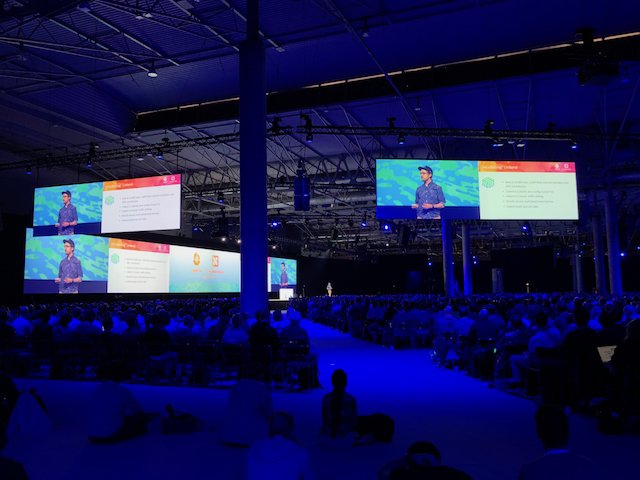
In our earlier post, Architecting for Multicluster Kubernetes, we outlined three requirements for building a simple yet resilient multicluster approach to Kubernetes: supporting hierarchical networks, preserving independence of cluster state, and not introducing a shared control plane.
In this post, we’ll propose a solution that we believe satisfies these constraints, called service mirroring. In keeping with Linkerd’s design principle of “keep it simple”, we’ve done our best to build this solution in terms of pure Kubernetes primitives and to remove any dependencies on Linkerd itself. This allows us to keep the operational surface area of any solution as close as possible to that of Kubernetes itself. In other words, the mesh should do less, not more.
We’re currently actively prototyping this approach and we’d love your feedback. Read on for details and how you can get involved.
Introduction
There are many challenges to building an effective multicluster Kubernetes architecture, including configuration, monitoring, deployment, and traffic management. Of these challenges, we see a service mesh as able to directly address three specific areas:
- Observability: a service mesh can provide a unified view of application behavior that spans clusters.
- Security: a service mesh can provide guarantees around authentication, authorization, and confidentiality to cross-cluster traffic.
- Routing: a service mesh can make it possible and “easy” for applications in one cluster to communicate with applications in another cluster.
Today, it is possible to build a multicluster setup that accomplishes many of these goals by running Linkerd independently across multiple clusters, aggregating metrics to an external Prometheus or Thanos, sharing service information in DNS, and using cert-manager to rotate certs on cluster Ingress controllers. (See our Multicluster the Kubernetes Way with Linkerd writeup, from which this framing is copied, for more on how to accomplish this.)
While functional, this approach has several downsides around cross-cluster calls. In contrast to in-cluster calls, cross-cluster calls in this approach don’t have full metrics, do not preserve source identity across the cluster boundary, and cannot be the target of traffic splitting. Most crucially, for even these partial guarantees to be made, the application itself must distinguish between on-cluster and cross-cluster calls. This runs counter to Linkerd’s goal of not requiring application changes.
Enter service mirroring.
Service Mirroring
The goal of the service mirroring is to allow the same guarantees that a service mesh like Linkerd provides for in-cluster calls—identity, traffic shifting, etc—to also be applied to cross-cluster calls. Service mirroring works, as the name suggests, by “mirroring” service information between clusters. With service mirroring in place, the full observability, security, and routing features of Linkerd apply uniformly to both in-cluster and cross-cluster calls, and the application does not need to distinguish between those situations.
The service mirror is a Kubernetes Operator. Once installed, it mirrors a remote cluster’s services locally to provide service discovery and allow pods to refer to the remote services. It also manages configuring endpoints so that traffic goes to the correct IP address. (Many more details below.)
The astute reader may note that nothing in service mirroring actually requires a service mesh. Instead, the service mirror is a standalone component that can compose well with other projects. This applies not just to the potential users of service mirroring, but also to the service mirror itself. For example, the service mirror’s gateway component is pluggable by design, and can be implemented by projects such as Ambassador, Gloo and Traefik.
To understand how service mirroring works, let’s take a quick trip to the origins of Kubernetes in the heart of the French Revolution.
A Tale of Two Clusters
It was the best of times, it was the worst of times. We have two Kubernetes clusters that need to send traffic between themselves. Let’s set the scene by describing these clusters and picking a specific task.

On the left, London has a pod named foo-client. On the right, Paris has a
service named bar. How do we make it possible for the foo-client pod to make
requests to the bar service?
Step 1: Service Discovery
Pods in the London cluster need to send requests to the bar service in Paris.
Normally, this would be done using the service name. However, bar is on
another cluster! Let’s copy the service definition from Paris to London.

At this point, the bar service has been copied to London. The remote cluster
name is appended, both to keep from having local collisions as well as allowing
pods to explicitly opt-in to sending requests off cluster. Immediately, the pods
in London will be able to start resolving the full service name -
bar-paris.default.svc.cluster.local. The bar-paris service living in London
has type ClusterIP. A virtual IP address will be created by London and be used
as the response to pods resolving the service name for bar-paris.
By copying services from Paris to London, we are maintaining independent state — one of our requirements. Paris has its own state, London has its own state and they are not dependent on each other. If the connectivity between London and Paris goes down, service updates will stop. That’s okay though! With connectivity failing, traffic can’t flow from London to Paris anyways.
We won’t be able to send traffic to the destination pods yet, unfortunately. The
pod selector from bar in Paris won’t match pods in London. In fact, we should
probably remove the selector just in case. It would be unintentional to have
traffic we intend to arrive in Paris accidentally end up in London instead.
Removing the selector lets us abstract the service beyond pods and use a
different backend.
Without a selector, the endpoint object cannot be created automatically. Kubernetes doesn’t know what to watch as we’ve not given it enough information. Having a service without a selector is something that Kubernetes was designed to work with though! Like all the resources in Kubernetes, you can create and manage them yourself. So, if we can create an endpoint ourselves and point it somewhere, where should the traffic be forwarded?
Step 2: Endpoint juggling
It would be possible to copy all the endpoints from Paris to London along with the service definition. Depending on how many pods are in the service, that could be a lot of data! Take a look at EndpointSlices to get a feel for just how much bandwidth replicating Endpoints across clusters could consume. Even with a solution to this problem, replicating individual pod IP addresses wouldn’t support hierarchical networks — another of our requirements. Instead of moving all this state between clusters, let’s introduce a single endpoint that can take care of routing traffic to the correct destination.

We have introduced a new service in Paris. With a type of LoadBalancer, the
gateway service will have a load balancer allocated. This load balancer will
have a public IP address that can forward traffic internally in Paris. We now
have an answer to the question of where requests from London should be sent to!
To get everything working, we can now create an Endpoints resource containing
this public IP address and send traffic there. At this point, requests issued in
London will resolve to the ClusterIP of bar-paris and get rewritten to the
public IP address of the gateway service in Paris. If the gateway service’s
selector targets the same pods as bar, everything would just work at this
point.
There are two important problems with our plan so far. Cloud load balancers are expensive, public ip addresses are few and far between. Creating an external load balancer for every service inside your cluster would quickly run out of ip addresses and push costs up to unacceptable levels.
Perhaps even more critically, if the gateway service points directly to bar, a
potentially sensitive internal service is now available on the greater internet.
It would be possible to configure firewall rules to restrict access, but that
feels pretty fragile. What could multiplex services across a single load
balancer and limit connectivity to authorized clients?
Step 3: The gateway
If you guessed that the solution to this problem sounds a lot like an ingress controller, you’d be right! Ingress resources allow configuration for the general case. As the ingress spec does not support wildcards, it isn’t possible to directly use Ingress resources to do this. Luckily, most ingress controllers support this use case! In fact, it is likely that your ingress controller of choice can already do wildcards in Kubernetes with a little configuration.

It is now possible to trace the life of a request as it originates in London and
ends up at the final destination in Paris. Starting out in London, a pod will
issue a request to bar-paris.default.svc.cluster.local. When the pod queries
DNS, it will receive the cluster IP for the service that resides in London. On
connect, the cluster IP will be rewritten to the public IP address of Paris’
gateway service. London’s pod will then connect to this IP address and have its
request forwarded to the ingress controller living in Paris. The ingress
controller can look at the incoming request’s host header and rewrite it to the
local bar service. After being rewritten, the request can finally reach the
destination pod, bar-server in Paris.
Passing requests through a load balancer running in Paris has the added benefit of making decisions locally on the cluster instead of remotely. As a local load balancer will always have a better picture of what is happening locally, the decision can be more optimal than one that originated outside the cluster. There’s definitely an extra hop, the introduction of an extra component which will end up doing routing in the local cluster does come with some added latency. The tradeoff is that multicluster communication is not a special case, services are exposed as if they were third party services and the tooling is identical between internal and external services.
As there is no private network in this example, data will traverse the public
internet. Encrypting all the cross-cluster traffic thus becomes critical.
Linkerd automatically does mTLS out of the box and takes care of the encryption
transparently. Sharing a
root certificate between
clusters allows Linkerd to validate both ends of the connection and encrypt all
traffic between them. The shared root certificate allows Linkerd’s control plane
in both clusters to be
completely independent,
fulfilling the final requirement. While Linkerd automates mTLS, it would be
possible to configure the gateway to present a wildcard certificate such as
*.default.svc.cluster.local which clients could then validate. Traffic would
be encrypted and validated by clients.
Note that the gateway works for TCP as well as HTTP with a caveat. Arbitrary TCP based protocols will not contain the information required for a gateway to forward the request to the correct destination. The gateway load balancer could map TCP ports, reserving one port for each internal service. As the service and endpoints are managed, port rewriting can occur without any requirements to clients or services. This naive solution can actually be improved significantly by utilizing something like ALPN or SNI at the TLS layer. Unfortunately, these solutions are not generally supported or configurable.
And that is service mirroring in a nutshell.
Want to get involved?
We’d love your feedback on service mirroring. Please leave us feedback on the service mirroring design doc. You can also email the cncf-linkerd-dev mailing list or find us on the Linkerd community Slack. We’re actively prototyping this solution today, and hope to have a functioning implementation very soon.
Linkerd is a community project and is hosted by the Cloud Native Computing Foundation. If you have feature requests, questions, or comments, we’d love to have you join our rapidly-growing community! Linkerd is hosted on GitHub, and we have a thriving community on Slack, Twitter, and the mailing lists. Come and join the fun!



